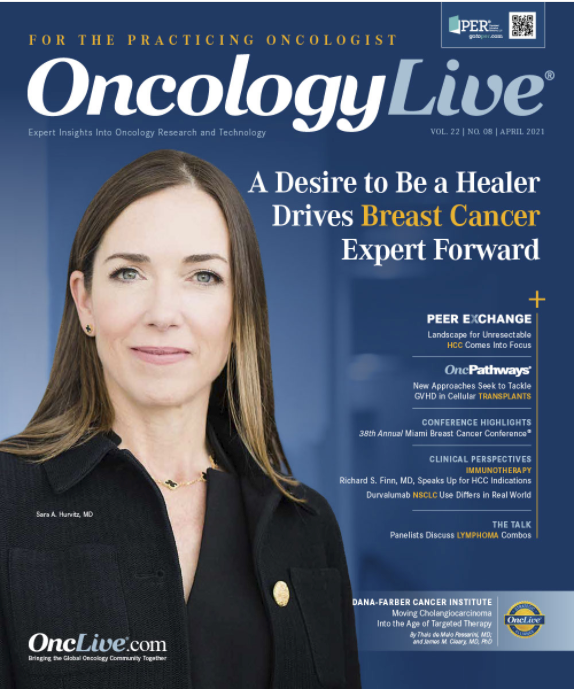Landscape for Unresectable HCC Comes Into Sharper Focus
After years of stagnation, the paradigm for treating patients with unresectable intermediate-stage or advanced hepatocellular carcinoma is starting to change as a result of novel strategies and evolving views of appropriate patient populations for systemic therapies.
Amit G. Singal, MD, MS

After years of stagnation, the paradigm for treating patients with unresectable intermediate-stage or advanced hepatocellular carcinoma (HCC) is starting to change as a result of novel strategies and evolving views of appropriate patient populations for systemic therapies, accord-ing to a panel of hepatobiliary oncology experts.
Because of its heterogeneity and complexity, with concomi-tant chronic liver disease being common, HCC has been difficult to treat, and survival has remained low, espe-cially in patients with intermediate or advanced disease, which is when HCC is usually diagnosed.1,2
The changing treatment landscape for patients with HCC was among the topics that panelists considered as part of a wide-ranging discussion about the malignancy during a recent OncLive Peer Exchange®. They also shared their insights on how they are using these agents in their clinical practice and factors they consider in their decision-making process, especially as the treatment landscape continues to evolve.
Richard S. Finn, MD

INTERMEDIATE-STAGE HCC
Most HCC studies have focused on patients with Barcelona Clinic Liver Cancer (BCLC) stage C disease, which is defined as advanced-disease on the scoring system. However, studies also have often included small subpopulations of patients with BCLC stage B disease, which is categorized as inter-mediate stage. These are patients who may have progressed on transarterial chemoembolization (TACE) or may not have qualified for TACE because of large multifocal bilobar disease or another contraindication to locoregional therapy.
The combination of atezolizumab (Tecentriq) and bevacizumab (Avastin) has shown promise as first-line therapy vs sorafenib (Nexavar) for patients with unresectable BCLC stage B disease in the phase 3 IMbrave150 trial (NCT0343479). Subgroup analyses (n = 78) showed a 35% reduction in the risk of progression or death (HR, 0.65; 95% CI, 0.33-1.30) but not for over-all survival (OS), where the HR was 1.09 (95% CI, 0.33-3.53).3
“In terms of the first-line standard of care for most patients in the unresectable stage, there was an interesting signal that people may have ‘overinterpreted’ in that subgroup analysis,” Amit G. Singal, MD, MS, said. He noted that progression-free survival (PFS) was significantly improved with atezolizumab/bevacizumab vs sorafenib but that OS was not improved. “The hazard ratio tends to be closer to 1, [and] some researchers interpreted those data to mean that atezolizumab may not work as well in the intermediate stage,” he said. However, he added, that while longer term data are awaited, he sees no reason why systemic therapy would not be as efficacious in the intermediate stage. He also noted that real-world data of sorafenib and lenvatinib (Lenvima) have shown these agents to work equally well in the locoregional space as in the systemic space.
Daniel H. Ahn, DO

Moderator Richard S. Finn, MD, added, “The phase 3 studies are not always powered to look at these smaller subgroups, but we often see a trend where the PFS and OS [are] very long for the intermediate group, and these patients go on to receive other treatments, which may make it more difficult to show an OS benefit for this group.”
A key challenge, however, is identifying the right candidates for systemic therapy and then deciding which agent may be most appropriate, particularly because there is significant heterogeneity even within this patient population. “Within BCLC stage B, there is a very gray area for who qualifies. We have to compare the role of systemic therapy with locoregional therapy, especially with a lot of these new emerging options that seem to have high response rates and durable responses that can provide an equal benefit and potentially be more efficacious,” Daniel H. Ahn, DO, said.
Still a Role for TACE?
TACE has been the standard of care for patients with intermediate-stage HCC, but there are patients who do not benefit from this treatment.1 “TACE was done in an era when we didn’t have many systemic treatments,” Daneng Li, MD, said. Subsequently, he noted that 3 key areas need further exploration to determine if or where TACE may fit in today’s treatment armamentarium: (1) whether use in combination with systemic therapies has benefit; (2) whether systemic therapies truly render TACE obsolete; and (3) whether sequential therapy with TACE may have benefit (ie, priming the tumor with systemic therapy and then using TACE).
Daneng Li, MD

Li said that several trials are underway to explore TACE in combination with systemic therapies. He noted that in a 2019 study by Kudo et al, which explored lenvatinib as an initial treatment in patients with intermediate HCC and bulky tumors, approximately 60% of patients in the lenvatinib arm went on to receive TACE.1 “The patients who had CRs [complete responses] were those patients who were primed with lenvatinib and then sequentially received TACE,” he said.
Finn said that combining TACE with VEGF inhibitors makes sense biologically. “We know that TACE induces ischemia and embolizes the tumor, and ischemia is a very potent driver of VEGF expression and secretion,” he said. Josep M. Llovet, MD However, another key question is whether antiangiogenic therapies like VEGF inhibitors offer the best combination approach.
“In my view, enough attempts have been made for the combination of TACE with a single-agent antiangiogenic. It’s not f lying, and I think that what’s going to fly is the testing of immune response,” Josep M. Llovet, MD, said. “What is going to change the role of systemic therapies is the introduction of immune therapies in the intermediate setting. The role of antiangiogenic agents will be a stage to boost the immune response.” Several ongoing clinical trials are exploring immunotherapies in combination with TACE (TABLE 1).2,4-6
TABLE 1. Ongoing Trials Exploring TACE and Immunotherapy Combinations for Intermediate-Stage HCC

TREATING ADVANCED HCC
The panelists noted the recent “huge evolution” in treating advanced disease after a decade-long drought following the approval of sorafenib in 2007. In 2018, FDA approvals in the first- and second-line settings started to roll in. This included approval of lenvatinib, which was found to be noninferior to sorafenib in the first-line setting in the REFLECT study (NCT01761266), demonstrating a median OS of 13.6 months vs 12.3 months for sorafenib.7 Then, in 2020, the FDA approved atezolizumab/bevacizumab as another first-line treatment based on data from the IMbrave150 study.8
Josep M. Llovet, MD

“[This combination] showed significant activity for the first time with a regimen that was superior to sorafenib in terms of OS,” Finn said.
At the time of FDA approval, the median OS in the atezolizumab/bevacizumab arm had not yet been reached vs 13.2 months in the sorafenib arm.8 “We saw a significant risk reduction vs sorafenib. The hazard ratio was 0.58, so a 42% decrease in the risk of death with atezolizumab/bevacizumab vs sorafenib. This was supported by a similar benefit in PFS,” Finn said.
During the 2021 Genitourinary Cancers Symposium, updated IMbrave150 data were presented, which provided more than 15 months of follow-up.9 The median OS was found to be 19.2 months with atezolizumab/ bevacizumab vs 13.4 months with sorafenib (HR, 0.66; 95% CI, 0.52-0.85; P = .0009). “We also saw an improvement in the response rate with longer follow-up. The response rate is now 30%, with 8% CRs,” Finn said. “We now have a regimen that I would characterize as highly active.”
Establishing Candidacy for First-Line Atezolizumab/Bevacizumab
Atezolizumab/bevacizumab is considered the National Comprehensive Cancer Network (NCCN) preferred first-line systemic therapy for patients with Child-Pugh class A status because of its superior OS.10 However, not all patients are candidates, and the panelists discussed the importance of selecting the right patient for this treatment vs sorafenib or lenvatinib.
Laura M. Kulik, MD

The NCCN guidelines indicate that endoscopy should occur approximately 6 months before treatment.10 Whether that window can ultimately be extended, such as to 9 or 10 months prior to treatment, remains unclear, Finn noted.
Upper endoscopy is standard for any patient with cirrhosis prior to starting therapy, but it becomes even more critical when considering treatment with atezolizumab/ bevacizumab because of the higher risk of bleeding with bevacizumab, Singal said. He added that it is important to ensure that patients do not have any large varices, signs of bleeding, significant portal gastropathy, significant thrombocytopenia, or any other f indings that may increase their bleeding risk. “We see patients who are Child-Pugh A with a higher platelet count who still have a risk of varices. There is no noninvasive way to assess this up front,” he added.
Laura M. Kulik, MD, agreed. “What you don’t want to see happen is people say, ‘We don’t want the delay and, therefore, we’re not going to do the endoscopy,’ and then you have someone die of a major variceal bleed,” she said.
Identification of varices, however, does not automatically contraindicate use of atezolizumab/bevacizumab. “Without portal vein invasion, the varices can be manageable,” Llovet said. “But in the case of patients with portal vein invasion, the varices will not be easy to treat with banding or with drugs. I would treat these cases with a single agent and either lenvatinib or sorafenib in the frontline setting.”
Considering Subsequent-Line Treatments
Several agents are available for use in the second line and beyond (TABLE 210), adding challenges to the treatment decision- making process, especially since the data for these agents were generated in the pre-atezolizumab/bevacizumab era. Li said the question of what to do after atezolizumab/ bevacizumab is the one providers struggle with the most in clinical practice, with people generally falling into 1 of 2 camps: those who treat with another first-line agent, particularly sorafenib or lenvatinib, and those who treat with traditional subsequent-line agents, such as cabozantinib (Cabometyx) or regorafenib (Stivarga).
There are no substantive data to guide decision-making, but Li said a poster presented at the 2021 Genitourinary Cancers Symposium examined this issue retrospectively in the real world, providing some preliminary insights.11 The study was small, including 49 patients who received sorafenib (n = 29), lenvatinib (n = 19), or cabozantinib (n = 1) after progression on atezolizumab/bevacizumab. He noted that 3 of 19 patients in the lenvatinib group had a partial response and that the sorafenib group and the cabozantinib-treated patient had stable disease.
“Interestingly, the disease control rate was equivalent, essentially a little over 60% for both sorafenib and lenvatinib,” he said. Although the trend favored lenvatinib, no OS benef it was observed. While these data may provide some comfort to providers who tend to reach for the other first-line agents, he said that data from larger patient cohorts and a broader variety of agents are needed to help provide better insights on how to best sequence treatments.
Treatment choices also may be complicated for the use of nivolumab (Opdivo) and pembrolizumab (Keytruda) monotherapy after f irst-line sorafenib. The FDA is reviewing accelerated approvals for those indications.12
Meanwhile, data beyond second-line therapy are sparse, the panelists noted. Singal pointed out, however, that the CELESTIAL trial (NCT01908426), which led to the approval of cabozantinib in the subsequent-line setting, included 27% of patients who had received 2 prior lines of therapy.13 He emphasized that cabozantinib should not necessarily be reserved only for the third line. “If you really feel that somebody can get to 3 lines of therapy, it’s one of the only drugs that we have evidence for in that setting,” he said.
TABLE 2. NCCN Recommended Subsequent-Line Therapies for HCC

References
- Kudo M, Ueshima K, Chan S, et al. Lenvatinib as an initial treatment in patients with intermediate-stage hepatocellular carcinoma beyond up-to-seven criteria and Child-Pugh A liver function: a proof-of-concept study. Cancers (Basel). 2019;11(8):1084. doi:10.3390/cancers11081084
- Ogasawara S, Llovet J, El-Khoueiry A, et al. LEAP-012: aA randomized, double-blind, phase 3 study of pembrolizumab plus lenvatinib in combination with transarterial chemoembolization (TACE) in patients with intermediate-stage hepatocellular carcinoma not amenable to curative treatment (P-107). Ann Oncol. 2020;31(suppl 3):S124-S125. doi:10.1016/j.annonc.2020.04.189
- Finn RS, Qin S, Ikeda M, et al; IMbrave150 Investigators. N Engl J Med. 2020;382(20):1894-1905. doi:10.1056/NEJMoa1915745
- Sangro B, Kudo M, Qin S, et al. A phase 3, randomized, double-blind, placebo-controlled study of transarterial chemoembolization combined with durvalumab or durvalumab plus bevacizumab therapy in patients with locoregional hepatocellular carcinoma: EMERALD-1 (P-347). Ann Oncol. 2020;31(suppl 3):S202-203. doi:10.1016/j.annonc.2020.04.429
- Nivolumab in combination with TACE/TAE for patients with intermediate stage HCC (TACE-3). ClinicalTrials.gov. Updated July 16, 2020. Accessed March 30, 2021. https://clinicaltrials.gov/ct2/show/NCT04268888
- Sangro B, Harding JJ, Johnson M, et al. A phase III, double-blind, randomized study of nivolumab (NIVO) and ipilimumab (IPI), nivo monotherapy or placebo plus transarterial chemoembolization (TACE) in patients with intermediate-stage hepatocellular carcinoma (HCC). J Clin Oncol. 2021;39(suppl 3):TPS349. doi:10.1200/JCO.2021.39.3_suppl.TPS349
- Kudo M, Finn RS, Qin S, et al. Lenvatinib versus sorafenib in first-line treatment of patients with unresectable hepatocellular carcinoma: a randomised phase 3 non-inferiority trial. Lancet. 2018;391(10126):1163-1173. doi: 0.1016/S0140-6736(18)30207-1
- FDA approves atezolizumab plus bevacizumab for unresectable hepatocellular carcinoma. FDA. Updated June 1, 2020. Accessed March 30, 2021. https://bit.ly/3cBsZGN
- Finn RS, Qin S, Ikeda M, et al. IMbrave150: updated overall survival (OS) data from a global, randomized, open-label phase III study of atezolizumab (atezo) + bevacizumab (bev) versus sorafenib (sor) in patients (pts) with unresectable hepatocellular carcinoma (HCC). J Clin Oncol. 2021;39(suppl 3):267. doi:10.1200/JCO.2021.39.3_suppl.267
- NCCN. Clinical Practice Guidelines in Oncology. Hepatocelluar carcinoma, version 1.2021. Accessed March 30, 2021. https://www.nccn.org/professionals/physician_gls/pdf/hepatobiliary.pdf
- Yoo C, Kim JH, Ryu MH, et al. Clinical outcomes with multikinase inhibitors after progression on first-line atezolizumab plus bevacizumab in patients with advanced hepatocellular carcinoma: aA multinational, multicenter retrospective study. J Clin Oncol. 2021;39(suppl 3):272. doi:10.1200/JCO.2021.39.3_suppl.272
- FDA in brief: FDA Oncologic Drugs Advisory Committee to review status of six indications granted accelerated approval. FDA. March 15, 2021. Accessed April 1, 2021. https://bit.ly/3cgG1bm
- Abou-Alfa GK, Meyer T, Cheng AL, et al. Cabozantinib in patients with advanced and progressing hepatocellular carcinoma. N Engl J Med. 2018;379(1):54-63. doi:10.1056/NEJMoa1717002




